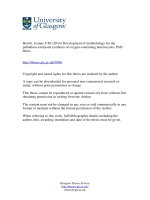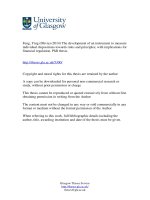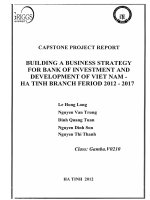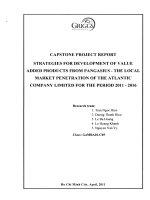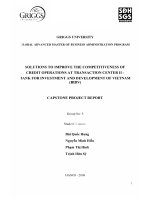Development of hollow fiber membrane bioreactors for two phase biodegradation of phenol
Bạn đang xem bản rút gọn của tài liệu. Xem và tải ngay bản đầy đủ của tài liệu tại đây (3.92 MB, 231 trang )
DEVELOPMENT OF HOLLOW FIBER MEMBRANE
BIOREACTORS FOR TWO-PHASE BIODEGRADATION
OF PHENOL
PRASHANT PRAVEEN
(B. Tech. (Hons.), SASTRA University, India)
A THESIS SUBMITTED FOR THE DEGREE OF
DOCTOR OF PHILOSOPHY
DEPARTMENT OF CHEMICAL AND BIOMOLECULAR
ENGINEERING
NATIONAL UNIVERSITY OF SINGAPORE
2012
ACKNOWLEDGEMENTS
The past four years of PhD has been a roller coaster ride, filled with a myriad of
emotions, some pleasure, some adventure and some frustration. As I prepare to
conclude my dissertation, it is now time to thank all the people who helped me
complete this arduous journey.
First of all, I would like the express my gratitude to my thesis supervisor, Associate
Professor Loh Kai-Chee. I would like to thank him for all the independence, the trust,
the encouragement, the motivation, the finances, the discussions, the criticism, the
corrections, for instilling in me tremendous confidence and data interpretations skills,
for my first job as a scientist, and for being the inspiration I am so keen to emulate.
I would like to thank all my current and former lab mates, Dr. Satyen Gautam, Dr.
Karthiga Nagarajan, Dr. Vivek Vasudevan, Dr. Cheng Xiyu and Ms. Phay Jia-Jia. My
special thanks to my fellow riders Ms. Nguyen Thi Thuy Duong and Ms. Vu-Tran
Khanh Linh for being wonderful friends, and for all the stolen moments from their
busy schedule which were translated into laughter and jollification.
I thank our lab officers Ms. Tay Alyssa, Mr. Ang Wee Siong and Ms. Xu Yanfang for
all the help rendered in this research, and Ms. Ng Sook Poh for designing the glass
modules for membrane contactor fabrication.
Finally, I would like to thank my parents, my wife and my brother. It is their love,
prayers and blessings which have been my strength to carry on. I would not have
achieved whatever I have, if not for them. Not to forget are my dear friends,
especially Mr. Rahul Modi who is keenly awaiting my graduation date. I thank them
all.
i
TABLE OF CONTENTS
ACKNOWLEDGEMENTS ..................................................................................................................... i
TABLE OF CONTENTS ........................................................................................................................ ii
SUMMARY ............................................................................................................................................ v
LIST OF TABLES ................................................................................................................................. ix
LIST OF FIGURES ............................................................................................................................... xi
LIST OF ABBREVIATIONS ............................................................................................................... xv
LIST OF SYMBOLS .......................................................................................................................... xvii
1
2
Introduction ..................................................................................................................................... 1
1.1
Background and Motivations .................................................................................................. 1
1.2
Research Objectives and Scope .............................................................................................. 8
1.3
Thesis Organization .............................................................................................................. 11
Literature Review.......................................................................................................................... 12
2.1
2.1.1
Design Considerations .................................................................................................. 12
2.1.2
Liquid/Liquid TPPB...................................................................................................... 17
2.1.3
Solid/liquid TPPB ......................................................................................................... 21
2.2
3
Two-Phase Partitioning Bioreactors ..................................................................................... 12
Membrane Enhanced Solvent Extraction .............................................................................. 25
2.2.1
Non-Dispersive Solvent Extraction............................................................................... 26
2.2.2
Hollow Fiber Supported Liquid Membranes ................................................................ 29
2.3
Hollow Fiber Membrane Bioreactors in Biodegradation ...................................................... 36
2.4
Conclusions ........................................................................................................................... 40
Materials & Methods .................................................................................................................... 41
3.1
Microorganisms, Culture Conditions, and Chemicals .......................................................... 41
3.2
Solvent Selection .................................................................................................................. 42
3.2.1
Determination of Distribution Coefficients .................................................................. 42
3.2.2
Biodegradation of Organic Solvents ............................................................................. 43
3.2.3
Biocompatibility of Organic Solvents ........................................................................... 43
3.3
Membrane Contactor Fabrication ......................................................................................... 44
3.4
Preparation of the EIHFMs ................................................................................................... 47
3.5
EIHFM Contactor Fabrication .............................................................................................. 47
3.6
Membrane Contactor Sterilization ........................................................................................ 48
ii
3.7
3.7.1
TPPB Operation ............................................................................................................ 48
3.7.2
HFMB Operation .......................................................................................................... 49
3.7.3
HFSLMB Operation...................................................................................................... 52
3.7.4
Adsorption/Desorption of Phenol on EIHFMs ............................................................. 53
3.7.5
EIHFMB Operation....................................................................................................... 54
3.8
4
Analytical Methods ............................................................................................................... 55
Two-phase Biodegradation of Phenol in a Hollow Fiber Membrane Bioreactor.......................... 57
4.1
Introduction ........................................................................................................................... 57
4.2
Results and Discussions ........................................................................................................ 59
4.2.1
Single-phase Biodegradation of Phenol ........................................................................ 59
4.2.2
Solvent Selection........................................................................................................... 61
4.2.3
TPPB Operation ............................................................................................................ 62
4.2.4
HFMB Operation .......................................................................................................... 64
4.2.5
Comparison between HFMB and TPPB ....................................................................... 73
4.2.6
Simultaneous Extraction and Biodegradation ............................................................... 76
4.3
5
Experimental Setup ............................................................................................................... 48
Conclusions ........................................................................................................................... 80
Kinetic Modeling of Two-Phase Biodegradation in a Hollow Fiber Membrane Bioreactor ........ 82
5.1
Introduction ........................................................................................................................... 82
5.2
Theory ................................................................................................................................... 85
5.2.1
Cell Growth Kinetics .................................................................................................... 85
5.2.2
Overall Mass Transfer Coefficients .............................................................................. 86
5.2.3
Resistance in Series Model ........................................................................................... 88
5.2.4
Estimation of Mass Transfer Coefficients..................................................................... 90
5.3
Model Equations ................................................................................................................... 92
5.4
Results & Discussion ............................................................................................................ 93
5.4.1
Parameter Estimation .................................................................................................... 93
5.4.2
Model Validation and Analysis..................................................................................... 95
5.4.3
Parameter Sensitivity Analysis ................................................................................... 100
5.4.4
Model Simulations ...................................................................................................... 101
5.5
Conclusions ......................................................................................................................... 110
6 Simultaneous Extraction and Biodegradation of Phenol in a Hollow Fiber Supported Liquid
Membrane Bioreactor ......................................................................................................................... 112
6.1
Introduction ......................................................................................................................... 112
6.2
Results & Discussion .......................................................................................................... 116
6.2.1
Two-phase biodegradation of phenol .......................................................................... 116
iii
6.2.2
Effects of substrate concentration ............................................................................... 121
6.2.3
Effects of Phase Ratio ................................................................................................. 125
6.2.4
Effect of flow rates ...................................................................................................... 126
6.2.5
Effects of interfacial area ............................................................................................ 130
6.2.6
Bioreactor Sustainability ............................................................................................. 134
6.3
Conclusions ......................................................................................................................... 139
7 Development of Extractant Impregnated Hollow Fiber Membranes for Adsorption of Phenol
from Wastewater ................................................................................................................................. 140
7.1
Introduction ......................................................................................................................... 140
7.2
Theoretical .......................................................................................................................... 143
7.2.1
Adsorption kinetics modeling ..................................................................................... 143
7.2.2
Adsorption isotherm.................................................................................................... 145
7.3
Results and Discussion ....................................................................................................... 146
7.3.1
Characterization of EIHFM ........................................................................................ 146
7.3.2
Adsorption/Desorption on EIHFM ............................................................................. 148
7.3.3
Adsorption kinetics ..................................................................................................... 151
7.3.4
Regeneration and Stability .......................................................................................... 155
7.3.5
Application to TPPB ................................................................................................... 158
7.4
Conclusions ......................................................................................................................... 161
8 Two-Phase Biodegradation of Phenol in an Extractant Impregnated Hollow Fiber Membrane
Bioreactor............................................................................................................................................ 162
8.1
Introduction ......................................................................................................................... 162
8.2
Results and Discussion ....................................................................................................... 165
8.2.1
Cell Growth and Biodegradation ................................................................................ 165
8.2.2
Biodegradation Stages................................................................................................. 169
8.2.3
Effects of Substrate Concentration.............................................................................. 172
8.2.4
Effects of Interfacial Area ........................................................................................... 175
8.2.5
Effects of Flow Rate ................................................................................................... 176
8.2.6
Bioreactor Stability ..................................................................................................... 178
8.3
9
Conclusions ......................................................................................................................... 181
Conclusions and Recommendations for Future Work ................................................................ 182
9.1
Conclusions ......................................................................................................................... 182
9.2
Recommendations for Future Work .................................................................................... 186
REFERENCES ................................................................................................................................... 190
LIST OF PUBLICATIONS AND PRESENTATIONS ...................................................................... 209
iv
SUMMARY
The advent of two-phase partitioning bioreactors (TPPB) can be hailed as one of the
most significant developments in the fields of biodegradation in the past decade.
These bioreactors utilize a non-aqueous sequestering phase to reduce the effective
concentration of toxic substrates in the cell culture medium, thereby enabling
suspended bacteria to withstand and metabolize high substrate concentrations. In this
research, we aimed to develop hollow fiber membrane-based bioreactors to mitigate
the challenges encountered in conventional TPPBs during two-phase biodegradation.
The model pollutant selected was phenol and Pseudomonas putida was the
biodegrading bacterium. Introducing hollow fiber membranes between the aqueous
and the organic phases prevented phase dispersion, which eliminated various
operating problems in TPPBs and provided a solvent-free growth environment to the
microorganisms. In a further study, hollow fiber membranes impregnated with solid
extractant TOPO using carrier solvent dichloromethane transformed the membrane
itself into the partitioning phase.
A hollow fiber membrane bioreactor (HFMB) resembling a shell and tube dialysis
module was first developed for aqueous/organic two-phase biodegradation of phenol
and the results were compared with that in a conventional TPPB. The suspended cells
in the HFMB could biodegrade inhibitory phenol concentrations at 600-2000 mg/L
without experiencing severe substrate inhibition. For example, 1000 mg/L phenol was
completely biodegraded in 46 hours at a maximum specific growth rate of 0.49 hr -1.
Phenol removal started at an exponential rate subsequently taking on a linear profile
under nutrient limitation. The HFMB offered a better growth environment for the
cells as evident from the absence of the lag phase and could mitigate the dispersion-
v
associated problems of foaming and emulsification. It was also observed that for
comparable mass transfer flux across the aqueous/organic interface, biodegradation
was faster in the HFMB as compared to that in the TPPB.
During simultaneous extraction and biodegradation of phenol from wastewater,
phenol concentrations of 1000, 1500 and 2000 mg/L were biodegraded within 28, 36
and 45 hours, respectively. The cell growth rates and biomass yields were comparable
to those observed in single-phase biodegradation systems. A kinetics model was
developed to elucidate the mass transfer mechanism and phenol metabolism in the
HFMB. The overall mass transfer coefficients in the shell and the lumen sides were
determined to be 4.58 x 10-8 and 1.51 x 10-6 m/s, respectively, using relevant
empirical correlations. The model corroborated the experimental data very well and it
was applied to simulate cell growth and biodegradation profiles for various case
studies involving variations in the operating conditions.
In the second part of this research, an improvement in the biodegradation performance
was brought about by limiting the presence of the organic solvent to a liquid
membrane supported on the hollow fiber membranes. The resulting hollow fiber
supported liquid membrane bioreactor (HFSLMB) offered improved biodegradation
performance during concomitant extraction and biodegradation of phenol. In the
HFSLMB, phenol was extracted from the wastewater by dispersing a small amount of
organic phase into the wastewater, whereas mass transfer between the solvent and the
culture medium was non-dispersive. This semi-dispersive configuration stabilized the
liquid membrane and facilitated solvent-free cell growth environment analogous to
that in the HFMB. P. putida could biodegrade phenol at 1000-4000 mg/L without
experiencing severe substrate inhibition. For example, 4000 mg/L phenol was
biodegraded within 76 hours while the specific growth rate and biomass yield were
vi
0.31 hr-1 and 0.26 g/g, respectively. Substrate removal occurred in two sequential
steps: removal during log growth phase and removal under diffusion limitation. The
biodegradation rates were enhanced by changing the phase ratio, hydrodynamic
conditions and the interfacial area. Repeated batch runs were conducted for more than
400 hours to evaluate long term stability of the HFSLMB.
The focus of the third part of the thesis was the incorporation of the organic phase into
the hollow fiber membranes for solid/liquid two-phase biodegradation of phenol. A
technique was developed to impregnate polypropylene hollow fiber membranes with
an organic extractant – trioctylphosphine oxide (TOPO). Scanning electron
microscopy showed white deposits of TOPO dispersed non-uniformly within the cross
sections and external surface of the extractant-impregnated hollow fiber membranes
(EIHFM). The EIHFMs manifested high sorption capacity and mass transfer rates,
with adsorption equilibrium attained within 10-30 minutes of operation. Adsorption
kinetics was examined using pseudo-first-order, pseudo-second-order and intraparticle
diffusion models, while the sorption capacities were modeled after the Langmuir and
Freundlich isotherms. Desorption of phenol from the EIHFMs was comparatively
slower but the regeneration of the adsorbents was quite effective. During repeated
operation with 1000 mg/L phenol, the adsorption capacities of the EIHFMs remained
constant at 32.2 ± 1.3 and 52.3 ± 0.9 mg/g, with indicates high stability of TOPO
immobilization in the polypropylene membranes.
The EIHFMs, when used as the non-aqueous phase in a TPPB, alleviated substrate
inhibition on P. putida by rapidly reducing aqueous phenol concentrations to subinhibitory levels. Although a short lag phase was observed during each experiment,
subsequent high specific growth rates exhibited by the cells resulted in rapid removal
vii
of 800-2500 mg/L phenol in the extractant impregnated hollow fiber membrane
bioreactor (EIHFMB). It was also demonstrated that a higher concentration of phenol
could be biodegraded by increasing the length of the EIHFMs. Since the changes in
the flow rate did not affect biodegradation rate, it was inferred that biodegradation in
the EIHFMB was not limited by mass transfer. The EIHFMB also exhibited high
performance stability over a period of 400 hours.
The results from this research demonstrate the strengths and potential of the
combination of the hollow fiber membrane technology with TPPBs. In the
aqueous/organic configuration, the hollow fiber membranes acted as the semipermeable barrier to alleviate phase dispersion and its associated problems without
compromising the biodegradation performance. The resulting HFMB and HFSLMB
extricated mass transfer rates from high energy agitation and facilitated simultaneous
extraction and biodegradation. On the other hand, the EIHFM combined the
advantages of both solvent extraction and adsorption, resulting in a solventless TPPB
with high flexibility in the bioreactor’s configuration and operation. It can thus be
concluded that the hollow fiber membrane based TPPBs are promising alternatives to
conventional two-phase biodegradation systems for the biodegradation of phenolic
compounds in wastewater treatment.
viii
LIST OF TABLES
Table 2.1 NAP selection criteria in TPPBs .............................................................................. 14
Table 2.2 Summary of research on liquid/liquid TPPB ........................................................... 18
Table 2.3 Summary of research on solid/liquid TPPB ............................................................ 22
Table 3.1 Composition of mineral medium ............................................................................. 42
Table 3.2 Specifications for the hollow fiber membranes ....................................................... 44
Table 3.3 Specifications for the two membrane contactors ..................................................... 45
Table 4.1 Solvent screening for the selection of organic phase in two-phase biodegradation of
phenol ....................................................................................................................................... 61
Table 4.2 Effects of phenol concentration on biodegradation parameters in TPPB ................ 64
Table 4.3 Effects of phenol concentration on biodegradation parameters in HFMB .............. 67
Table 4.4 Effects of membrane length on two-phase biodegradation of phenol in the HFMB
.................................................................................................................................................. 72
Table 4.5 Performance comparison of TPPBs in biodegradation of phenol............................ 73
Table 4.6 Comparison of TPPB and HFMB based on the operating problems typically
observed during two-phase biodegradation of phenol ............................................................. 76
Table 4.7 Effects of phenol concentration on biodegradation parameters in simultaneous
extraction and biodegradation of phenol in the HFMB ........................................................... 78
Table 5.1 Physical properties, equilibrium parameters and membrane characteristics used for
simultaneous extraction and biodegradation in HFMB ........................................................... 97
Table 5.2 Mass transfer coefficients at the operating conditions in the HFMB ...................... 98
Table 6.1 Summary of the experimental runs in the HFSLMB ............................................. 115
Table 6.2 Effects of initial phenol concentration on two-phase biodegradation in the
HFSLMB................................................................................................................................ 122
ix
Table 6.3 Effects of organic to aqueous phase ratio on two-phase biodegradation in the
HFSLMB................................................................................................................................ 127
Table 6.4 Effects of interfacial surface area on two-phase biodegradation in the HFSLMB 132
Table 7.1 Experimental sorption capacities using four sets of EIHFMs for different phenol
concentrations ........................................................................................................................ 151
Table 7.2 Kinetic rate constants (k), equilibrium adsorption capacities (Qe) and regression
coefficients (R2) obtained using different models for removal of phenol using TOPOcontaining EIHFM ................................................................................................................. 152
Table 7.3 Langmuir and Freundlich isotherm parameters for the four different sets of EIHFM
................................................................................................................................................ 154
Table 7.4 Adsorption capacities (Qe) of EIHFMs after washing with DCM ......................... 158
Table 8.1 Performance of conventional TPPBs in two-phase biodegradation of phenol ...... 170
Table 8.2 Effects of substrate inhibition on two-phase biodegradation of phenol in EIHFMB
................................................................................................................................................ 173
Table 8.3 Effect of aqueous flow rate on bioreactor parameters during biodegradation of 1000
mg/L phenol ........................................................................................................................... 178
x
LIST OF FIGURES
Figure 1.1 Schematic layout of the research program and the specific objectives .................. 10
Figure 2.1 Schematic diagram of an aqueous/organic TPPB .................................................. 13
Figure 3.1 Schematic diagram of the HFMB ........................................................................... 50
Figure 3.2 Schematic diagram of the HFMB in simultaneous extraction and biodegradation 51
Figure 3.3 Schematic diagram of the HFSLMB ...................................................................... 53
Figure 3.4 Schematic diagram of the EIHFMB ....................................................................... 55
Figure 4.1 Effects of substrate inhibition on: (a) cell growth; (b) specific growth rate and
biomass yield, during biodegradation of phenol in single-phase ............................................. 60
Figure 4.2 Temporal concentration profiles of biomass and phenol during biodegradation of
1000 mg/L phenol in TPPB ..................................................................................................... 63
Figure 4.3 Temporal concentration profiles of biomass, aqueous phenol, organic phenol and
total phenol in biodegradation of 1000 mg/L phenol in HFMB .............................................. 66
Figure 4.4 Effects of substrate concentration on: (a) phenol distribution between two-phases
and (b) effect of mass transfer limitation on biodegradation, for initial phenol concentrations
of 600, 1000, and 2000 mg/L ................................................................................................... 69
Figure 4.5 Temporal concentration profiles of biomass and phenol in HFMB with twin
modules at initial substrate concentration of 2000 mg/L ......................................................... 70
Figure 4.6 Effects of the membrane length on (a) aqueous phenol concentration; and (b)
phenol removal rate.................................................................................................................. 71
Figure 4.7 Comparison of the TPPB and HFMB of 60 cm effective length: (a) substrate
distribution between the aqueous and organic phases, and the distribution in TPPB after
offsetting the lag phase; (b) total phenol removal profiles ...................................................... 75
xi
Figure 4.8 Temporal concentration profiles of biomass, aqueous phenol, organic phenol, feed
phenol and total phenol in the HFMB during simultaneous extraction and biodegradation of
1000 mg/L phenol .................................................................................................................... 78
Figure 5.1 Schematic diagram of mass transfer process in extraction of phenol from feed
solution to the organic solvent ................................................................................................. 88
Figure 5.2 Specific growth rate of P. putida (ATCC 11172) on phenol ................................. 94
Figure 5.3 Two-phase biodegradation of 1000 mg/L of phenol in the HFMB: (a) feed and
organic phenol concentration profile; and, (b) biomass and aqueous phenol concentration
profile ....................................................................................................................................... 96
Figure 5.4 Experimental and modeled total phenol concentration profiles in the
biodegradation of 1000 mg/L phenol in the HFMB .............................................................. 100
Figure 5.5 Parameter sensitivity: (a) effects of b on the cell growth; and, (b) effects of ψB on
the organic phase phenol concentration ................................................................................. 102
Figure 5.6 Comparison of the experimental data and model simulations at feed phenol
concentration of 1500 mg/L: (a) feed and organic phenol concentration; and, (b) aqueous
phenol and biomass concentrations ....................................................................................... 104
Figure 5.7 Comparison of the experimental data and model simulations at feed phenol
concentration of 1500 mg/L: (a) feed and organic phenol concentration; and, (b) aqueous
phenol and biomass concentrations ....................................................................................... 105
Figure 5.8 Effects of flow rate on HFMB performance: (a) lumen side flow rate of 12
mL/min; and (b) shell side flow rate of 8 mL/min................................................................. 107
Figure 5.9 Model simulations to study: (a) effects of effect membrane length; and, (2) effects
of fiber packing density ......................................................................................................... 109
Figure 6.1 Temporal concentration profiles of biomass and phenol concentrations during twophase biodegradation of 1000 mg/L phenol in the HFSLMB................................................ 118
xii
Figure 6.2 Two-phase biodegradation of 1500 mg/L phenol in the HFLMB: (a) three different
stages of phenol removal; (b) changes in the distribution of phenol between the organic and
the two aqueous phases during biodegradation ..................................................................... 120
Figure 6.3 Effects of initial phenol concentration on two-phase biodegradation in the
HFLMB: (a) aqueous phase phenol concentration in the cell culture; (b) removal rates under
diffusion limitation................................................................................................................. 123
Figure 6.4 Temporal concentration profiles of biomass and phenol concentrations during twophase biodegradation of 4000 mg/L phenol in the HFSLMB at organic to aqueous phase ratio
of 1:6.67 ................................................................................................................................. 126
Figure 6.5 Effects of lumen side flow rate on two-phase biodegradation of phenol in the
HFSLMB: (a) total phenol concentration profiles; (b) removal rates under mass transfer
limitation ................................................................................................................................ 128
Figure 6.6 Effects of shell side flow rate on two-phase biodegradation of phenol in the
HFSLMB................................................................................................................................ 129
Figure 6.7 Effects of interfacial area on two-phase biodegradation of phenol in the HFSLMB:
(a) phenol concentration in the organic phase; (b) phenol concentration in the cell culture; (c)
removal rates under diffusion limitation ................................................................................ 131
Figure 6.8 Bioreactor sustainability studies for the HFSLMB: (a) feed phenol concentration
profiles; (b) Total phenol concentration profiles, for the 20 consecutive runs ...................... 136
Figure 6.9. Bioreactor sustainability studies for the HFSLMB: (a) biodegradation time and;
(b) biomass yields, for the 20 consecutive runs ..................................................................... 137
Figure 7.1 Cross-sections (a and b) and external surface (c) of untreated polypropylene
membrane and; cross-sections (d and e) and external surface (f) of the EIHFMs. ................ 147
Figure 7.2 Effects of contact time on adsorption of 1000 mg/L phenol for the four sets of
EIHFMs with varying TOPO concentration .......................................................................... 149
xiii
Figure 7.3 Effects of contact time on adsorption using EIHFM containing 100 g/L TOPO at
varying initial phenol concentrations ..................................................................................... 150
Figure 7.4 Pseudo-second-order sorption kinetics of 1000 mg/L phenol using different sets of
EIHFM with varying TOPO concentration............................................................................ 153
Figure 7.5 Langmuir isotherms for EIHFMs containing varying TOPO concentration
(markers represent experimental values and the dotted lines represent modeled values) ..... 155
Figure 7.6 Effects of contact time on desorption of phenol using all four sets of EIHFMs with
varying TOPO concentration after adsorption of phenol at 1000 mg/L ................................ 156
Figure 7.7 Sorption capacities of 50 and 200 g/L TOPO containing EIHFMs during
consequent runs at initial phenol concentration of 1000 mg/L .............................................. 157
Figure 7.8 Cell growth and substrate removal profiles in the TPPB at initial phenol
concentrations of: (a) 1000 mg/L and, (b) 2000 mg/L........................................................... 159
Figure 8.1 Temporal cell growth and phenol concentration profiles during biodegradation of
1000 mg/L in EIHFMB .......................................................................................................... 167
Figure 8.2 Temporal cell growth and phenol concentration profiles during biodegradation of
2000 mg/L in EIHFMB .......................................................................................................... 169
Figure 8.3 Two-phase biodegradation of 1500 mg/L phenol in the EIHFMB: (a) different
stages of phenol removal; (b) different stages of cell growth ................................................ 171
Figure 8.4 Cell growth and phenol removal profiles during biodegradation of 3000 mg/L
phenol at effective EIHFM length of 90 cm in the EIHFMB ................................................ 176
Figure 8.5 Effects of aqueous flow rate on the removal of 1000 mg/L phenol in the EIHFMB
................................................................................................................................................ 177
Figure 8.6 Comparison of cell growth and biodegradation profiles at initial phenol
concentration of 1000 mg/L, carried out after an interval of 400 hours of operation in the
xiv
EIHFMB. Solid shapes represent original profiles whereas open shapes represent the profiles
after 400 hours of repeated operation .................................................................................... 180
xv
LIST OF ABBREVIATIONS
Aq
Aqueous
BTX
Benzene, Toluene, Xylene
Conc
Concentration
DCM
Dichloromethane
EIHFM
Extractant impregnated hollow fiber membranes
EIHFMB
Extractant impregnated hollow fiber membrane bioreactor
EPS
Extra polymeric substances
EVA
Poly(ethylene-co-vinylacetate)
GAC
Granular activated carbon
GC
Gas chromatography
HFCLM
Hollow fiber contained liquid membrane
HFMB
Hollow fiber membrane bioreactor
HFRLM
Hollow fiber renewal liquid membrane
HFSLM
Hollow fiber supported liquid membrane
HFSLMB
Hollow fiber supported liquid membrane bioreactor
MSDS
Material safety data sheet
NAP
Non-aqueous phase
OD
Optical density
OMMT
Organic modified montmorillonite
Org
Organic
PAH
Poly aromatic hydrocarbons
PCP
Pentachlorophenol
xv
PEHFSD
Pseudo-emulsion-based hollow fiber strip dispersion
PSF
Polysulfone
PTFE
Polytetrafluoroethylene
PVA
Polyvinyl alcohol
PVDF
Polyvinylidene fluoride
RPM
Revolutions per second
SEM
Scanning electron microscopy
SLM
Supported liquid membrane
TBP
Tributyl phosphate
TCE
Trichloroethylene
TOA
Trioctylamine
TOPO
Trioctyl phosphine oxide
TPPB
Two phase partitioning bioreactor
TSP
Tetrasodium pyrophosphate
VOC
Volatile organic contaminant
VVM
Volume of gas per reactor volume per minute
xvi
LIST OF SYMBOLS
Ain
Interfacial area on the lumen side
Alm
Log mean area of the membrane
Aout
Interfacial area on the shell side
Au
Gold
b
Fraction of total biomass present as biofilms
C*feed
Hypothetical phenol concentration in aqueous phase that is in
equilibrium with that in the organic phase in the HFMB
C*org
Hypothetical phenol concentration in organic phase that is in
equilibrium with that in the aqueous phase in the HFMB
Ce
Equilibrium concentration of the solute in the solution
Cfeed
Phenol concentration in feed wastewater
Cifeed
Aqueous phenol concentration at the aqueous/organic interface
Ciorg
Organic phenol concentration at the aqueous/organic interface
Cmorg
Phenol concentration in solvent wetted membranes
Corg
Phenol concentration in organic solvent
Daq
Diffusivity of phenol in water
dh
Hydraulic diameter
din
Inside diameter of the membranes
dlm
Log mean diameter of the membranes
dout
Outside diameter of the membranes
Dorg
Diffusivity of phenol in 2-undecanone
J
Flux of phenol from one phase to another
Jfeed
Flux of phenol from aqueous feed to solvent phase
xvii
Jorg
Flux of phenol from solvent to aqueous phase
k1
Pseudo-first-order rate constant
k2
Pseudo-second-order rate constant
Kaq
Overall mass transfer coefficient on the aqueous side
n,kF
Freundlich isotherm constants
ki
Intraparticle diffusion rate constant
KI
Substrate inhibition constant
kL
Langmuir adsorption constant
km
Mass transfer coefficient in the membranes
Korg
Overall mass transfer coefficient on the organic side
Ks
Substrate affinity constant
ks
Mass transfer coefficient in the shell side boundary layer
kt
Mass transfer coefficient in the lumen side boundary layer
L
Effective length of the membranes
MB
Molecular weight of 2-undecanone
P
Partition coefficient
Qaq
Aqueous flow rate
Qe
Amount of phenol adsorbed at equilibrium
Qmax
Maximum adsorption capacity
Qorg
Organic flow rate
Qt
Amount of phenol adsorbed at any time
R2
Coefficient of regression
Re
Reynolds number
Sc
Schmidt number
xviii
Sh
Sherwood number
T
Temperature
t
Time
VA
Molar volume of phenol as liquid at its boiling point
Vaq
Volume of the aqueous phase
vaq
Aqueous flow rate
Vorg
Volume of the organic phase
X
Biomass concentration
Yxs
Yield coefficient
δ
Membrane thickness
ε
Porosity
η
Viscosity of 2-undecanone
ηaq
Viscosity of water
μ
Specific growth rate
μm
Maximum specific growth rate
ρaq
Density of water
τ
Tortuosity
φ
Packing density
ψB
Association parameter for 2-undecanone
xix
1
Introduction
1.1
Background and Motivations
Research in biodegradation of toxic aromatic compounds has made significant strides
in the past two decades. These developments have been propelled by the isolation of
microbial strains capable of metabolizing, hitherto, non-biodegradable xenobiotics
(Jain et al. 2005; Paul et al. 2005; Rieger et al. 2000); evolution of novel metabolic
pathways by genetic and metabolic engineering of existing biodegrading
microorganisms (Lovley 2003; Perez-Pantoja et al. 2008; Timmis and Pieper 1999);
and proteomics analysis of cellular responses to biodegradation (Cao and Loh 2008;
Loh and Cao 2008; Zhang et al. 2009). On the engineering front, several innovative
bioreactor designs (Daugulis et al. 2011; Juang et al. 2008; Loh et al. 2000; Loh and
Liu 2001; Saravanan et al. 2008; Singh et al. 2006; Tepe and Dursun 2008) with the
potential to metabolize high inhibitory concentrations of toxic aromatics have been
proposed. Most of these bioreactors, however, are based on cell immobilization and
do not exhibit high biodegradation rates.
Recently, two-phase partitioning bioreactors (TPPB) have been investigated as an
alternative to immobilized cell bioreactors in mitigating substrate inhibition. TPPBs
are based on the equilibrium distribution of a toxic substrate between the cell culture
medium and an immiscible non-aqueous phase (NAP), which can either be an organic
solvent (Juang et al. 2010; Munoz et al. 2008) or a polymeric adsorbent (Khan and
Daugulis 2011; Tomei et al. 2010). Due to the high affinity for the NAP, most of the
substrate partitions into the NAP during equilibration, resulting in a sub-inhibitory
substrate concentration in the aqueous phase, which is suitable for cell growth.
Microbial metabolism of the substrate disrupts the equilibrium resulting in a
1
unidirectional transport of the substrate from the NAP to the cell culture, which
eventually leads to the complete removal of the substrate from both the phases
(Daugulis et al. 2011).
This unique bioreactor configuration with biocompatible NAPs enables suspended
cells to withstand and metabolize high inhibitory concentrations of toxic aromatic
compounds at unprecedented high biodegradation rates. In one of the earliest reported
studies on TPPB, phenol concentrations up to 28 g/L were biodegraded by
Pseudomonas putida without experiencing severe substrate inhibition, using 2undecanone as the organic phase. The volumetric biodegradation rates reported were
135 mg/L-hr during batch operation and 175 mg/L-hr during fed-batch operation
(Collins and Daugulis 1997).
Most of the studies on two-phase biodegradation systems have been carried out using
organic solvents as the partitioning phase. These aqueous/organic TPPBs have been
very effective against the aromatic compounds and would have constituted an ideal
system; but a plethora of operating problems resulting from phase dispersion limits
their applicability. The primary challenge in these bioreactors is the presence of
emulsions which inflicts high downstream separation cost (Amsden et al. 2003).
Stable emulsions may also result in incomplete phase separation and consequent
release of the organic solvent into the environment as a secondary waste. The
emulsified cell growth medium is also prone to foaming when aerated, resulting in the
loss of the solvent into the environment (Quijano et al. 2009). Furthermore, the
presence of organic solvent laden with the toxic substrate in the cell culture medium is
harmful for the microorganisms and this often gives rise to long lag phases. It has also
been observed that some of the biosurfactants produced by the cells actually enhanced
emulsion stability (Cruickshank et al. 2000), further aggravating the massive task of
2
phase separation. The reliance of the TPPBs on high agitation rates for improved
performance is another limitation of these bioreactors which can be quite energy
intensive, especially when the solvent has a high viscosity. Agitation rates as high as
600 RPM have been reported during pyrene biodegradation using silicone oil as the
organic phase (Mahanty et al. 2008), which may be difficult to realize in a large-scale
bioreactor.
Some of the problems encountered using organic solvents in TPPBs have been
overcome by substituting the NAPs with polymeric adsorbents. These polymers
provide a cheaper, bio-friendlier and eco-friendlier alternative to conventional
solvents and are finding increasing application in two-phase biodegradation of
aromatic compounds (Prpich and Daugulis 2006). The solid NAPs modify the
underlying mechanism in TPPB from extraction/stripping to adsorption/desorption
which completely eliminates the problems of phase dispersion, while sequestering the
bulk of the substrate in the solid phase. The disadvantage of using solid NAP is the
lower diffusivity of the molecules in solids, which can result in low mass transfer
rates, eventually resulting in poor biodegradation rates (Zhao et al. 2009). Moreover,
these polymeric adsorbents have often been observed to exhibit low adsorption
capacities and if the regeneration is not effective, the long-term operation of the
solid/liquid TPPBs can be jeopardized. In addition, these TPPBs, in the current
configuration, are difficult to operate in a continuous mode due to the adsorbent
regeneration problems. For the same reason, these bioreactors cannot offer sustainable
simultaneous adsorption and biodegradation, as well.
Although phase dispersion-associated problems during two-phase processes such as
liquid/liquid extraction are often alleviated using membrane-based technologies
(Bocquet et al. 2006; González-Muñoz et al. 2003), these have seldom been explored
3

